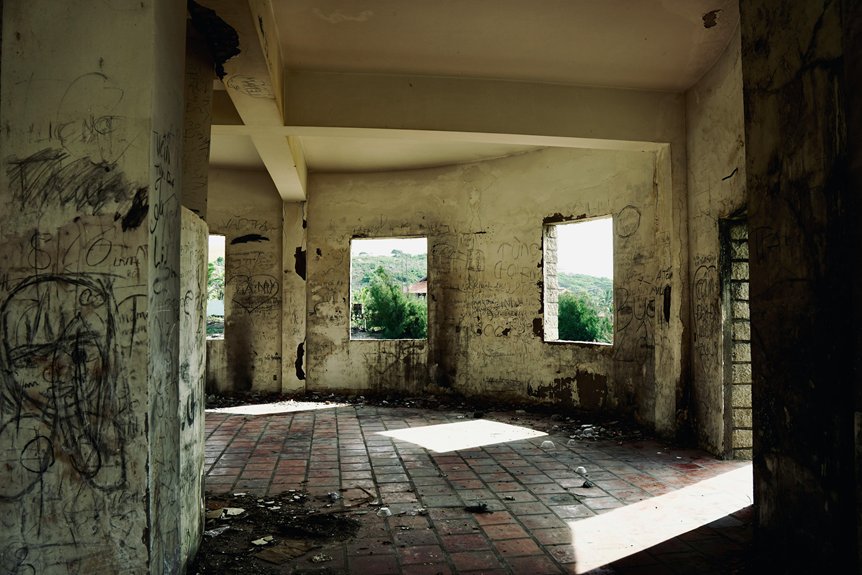Living near the coast means dealing with high humidity that can cause your floors to warp over time. By taking proactive steps to control moisture levels and choose the right materials, you can protect your home’s flooring. Proper maintenance and strategic upgrades are essential, but knowing exactly what measures to prioritize can make a significant difference in preventing costly damage. Keep these key strategies in mind as you explore ways to safeguard your floors from coastal humidity.
Monitor and Control Indoor Humidity Levels
Monitoring and controlling indoor humidity levels is vital to prevent floor warping in coastal areas. You can achieve this by installing humidity sensors to track moisture levels accurately. These sensors help you identify when humidity rises above safe thresholds, alerting you to take action.
Proper dehumidifier placement is essential; position units in areas prone to excess moisture, like near windows or bathrooms. Regularly monitor sensor readings and run the dehumidifier as needed.
Keeping humidity levels between 30-50% minimizes the risk of wood expansion or contraction. Staying vigilant with humidity sensors and strategic dehumidifier placement ensures your floors stay flat and damage-free.
Use Moisture-Resistant Flooring Materials
Choosing moisture-resistant flooring materials is one of the most effective ways to prevent warping in coastal environments. Your floor material selection should prioritize options like vinyl, tile, or sealed hardwood with moisture resistant coatings.
These materials resist water absorption, reducing the risk of warping caused by humidity. Additionally, applying moisture resistant coatings creates a protective barrier that prevents moisture infiltration.
Maintain Proper Ventilation Throughout Your Home
To prevent floor warping in coastal areas, maintaining proper ventilation throughout your home is essential. Humidity fluctuations can cause wood to expand and contract, leading to warping. Using effective ventilation systems helps regulate indoor moisture levels, reducing these fluctuations. Proper ventilation not only controls humidity but also prevents stale air buildup, which can worsen moisture problems. High-quality flooring materials can also withstand humidity changes better when proper ventilation is maintained, ensuring longevity and durability. Regularly maintaining your ventilation systems ensures they operate efficiently, helping you preserve your flooring and avoid costly repairs caused by warping.
Apply Sealants and Protective Coatings to Your Floors
Applying sealants and protective coatings creates a strong barrier against moisture, helping to safeguard your floors from the humidity fluctuations common in coastal areas.
Different sealant types, such as polyurethane, epoxy, or acrylic, offer varying levels of protection and durability.
Protective coatings, like waterproof sealers or varnishes, further shield your flooring from moisture infiltration.
Regularly applying these coatings helps prevent warping and damage caused by humidity changes.
Choose the right sealant type for your flooring material and guarantee proper application for maximum effectiveness.
Install a Vapor Barrier in Subflooring
Installing a vapor barrier beneath your subfloor is an effective way to prevent moisture from seeping into your flooring system. During subflooring installation, lay a high-quality vapor barrier directly on the concrete or ground before adding insulation or the subfloor panels.
This barrier acts as a moisture shield, reducing humidity buildup that can cause warping. Make certain the vapor barrier extends beyond the edges of the subfloor and is sealed tightly at seams to maximize protection.
Proper subflooring installation with a vapor barrier creates a moisture-resistant foundation, helping your floors stay stable and free from warping caused by coastal humidity.
Keep Indoor Spaces Well-Insulated
Keeping indoor spaces well-insulated is essential for preventing moisture from penetrating your home and causing floor warping. Make certain your windows are air tight to minimize drafts and moisture entry.
Proper insulation helps maintain a stable indoor humidity level, reducing the risk of wood expansion and contraction. Consider dehumidifier installation to control excess moisture in humid coastal environments.
These measures keep your interior dry and consistent, protecting your floors from warping. Well-insulated spaces also improve energy efficiency, making your home more comfortable.
Regularly Inspect and Address Moisture Issues
Regularly inspecting your home for signs of moisture buildup helps catch problems early before they cause significant damage. Look for warping or gaps in hardwood flooring, which may indicate seasonal wood expansion. Address leaks or condensation promptly to prevent moisture from seeping into the wood.
Use proper hardwood cleaning techniques—avoiding excess water and harsh chemicals—to keep your floors dry and clean. Maintaining a dry environment minimizes the risk of moisture-related issues that lead to warping.
Consistent inspections allow you to identify and fix problems quickly, preserving your floors’ integrity and preventing costly repairs caused by coastal humidity.
Adjust HVAC Settings for Optimal Humidity Control
Since humidity fluctuations are a common challenge in coastal areas, adjusting your HVAC settings is essential for maintaining ideal indoor moisture levels. Use humidity sensors to monitor real-time conditions and set your HVAC system to maintain a consistent humidity range.
Proper dehumidifier placement helps reduce excess moisture, especially in high-humidity zones. Keep your HVAC’s dehumidification mode active during wet seasons, and avoid overcooling, which can cause condensation.
Regularly check sensors and dehumidifiers to guarantee they’re functioning correctly. By fine-tuning your HVAC settings, you create a stable environment that prevents floor warping caused by excess moisture.
Conclusion
To keep your floors safe from warping in coastal humidity, stay on top of humidity levels with reliable sensors and dehumidifiers. Use moisture-resistant flooring, apply protective sealants, and ensure proper ventilation. Installing a vapor barrier and maintaining good insulation also help. Regular inspections and adjusting your HVAC settings will keep moisture in check. By consistently maintaining these measures, you’ll safeguard your floors and enjoy a stable, beautiful home regardless of coastal moisture challenges. To learn more about our amazing flooring options, call us today at (336) 270-9622 or visit us online at Floor Plus More.

